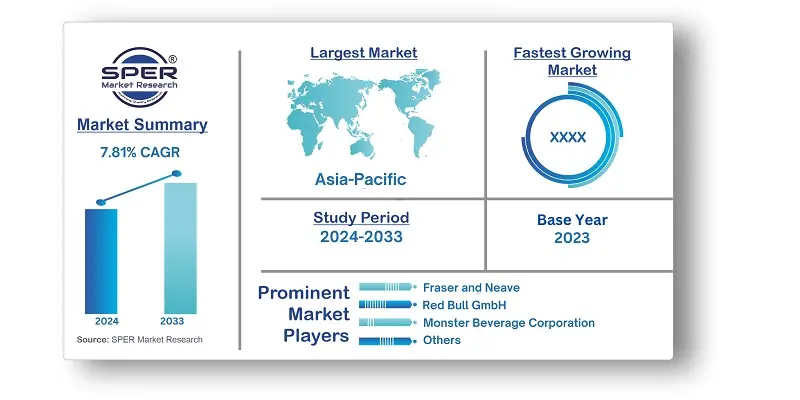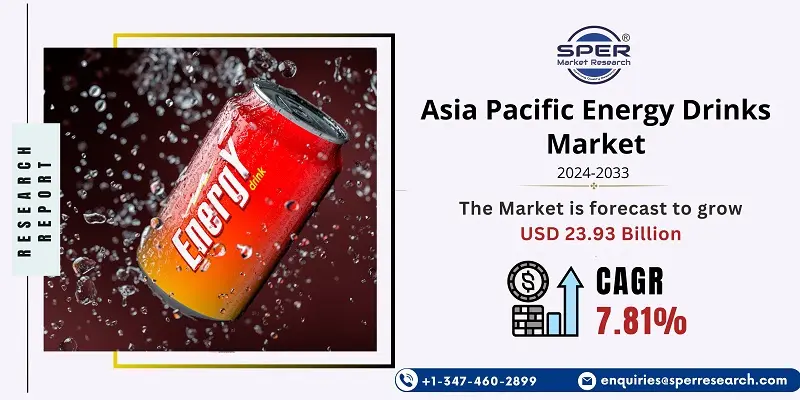
Asia Pacific Energy Drinks Market Growth, Size, Trends, Demand, Revenue and Future Outlook
Asia Pacific Energy Drinks Market Size- By Drink Type, By Packaging Type, By Ingredients- Regional Outlook, Competitive Strategies and Segment Forecast to 2033
| Published: Jul-2024 | Report ID: FOOD2484 | Pages: 1 - 155 | Formats*: |
| Category : Food & Beverages | |||
- September 2023; PepsiCo India introduced Sting Blue Current, a limited-edition flavor of its Sting Energy drink. Throughout India, 200 ml single-serve packs of Sting Blue Current are available.
- April 2023; Prime has introduced Prime Energy, a new energy drink with 200 mg of caffeine and no added sugar. The new drinks come in blue raspberry, tropical punch, lemon lime, orange mango, strawberry watermelon, and ten-calorie drinks with 300 mg of electrolytes.


| Report Metric | Details |
| Market size available for years | 2020-2033 |
| Base year considered | 2023 |
| Forecast period | 2024-2033 |
| Segments covered | By Drink Type, By Packaging Type, By Ingredients |
| Regions covered | Australia, China, India, Japan, South Korea, Rest of Asia-Pacific |
| Companies Covered | Eastroc Beverage Co., Ltd., Fraser and Neave, Limited, Fujian Dali Food Group Co., Ltd., Hangzhou Wahaha Group Co., Ltd., Monster Beverage Corporation, Nongfu Spring Co., Ltd., PepsiCo, Inc., Red Bull GmbH, Suntory Holdings Limited, and T.C. Pharmaceutical Industries Company Limited, Others. |
- Young Adults
- Athletes and Fitness Enthusiasts
- Working Professionals
- Students
- Gamers and E-Sports Participants
- Night Shift Workers
| By Drink Type: |
|
| By Packaging: |
|
| By Ingredients: |
|
- Asia Pacific Energy Drinks Market Size (FY’2024-FY’2033)
- Overview of Asia Pacific Energy Drinks Market
- Segmentation of Asia Pacific Energy Drinks Market by Drink Type (Energy Shots, Natural/Organic Energy Drinks, Sugar Free/Low Calories Drink, Traditional Energy Drinks)
- Segmentation of Asia Pacific Energy Drinks Market by Packaging (Glass Bottles, Metal Can, PET Bottles)
- Segmentation of Asia Pacific Energy Drinks Market by Ingredients (Taurine, Caffeine, Guarana, Vitamin B, L-Carnitine, Others)
- Statistical Snap of Asia Pacific Energy Drinks Market
- Expansion Analysis of Asia Pacific Energy Drinks Market
- Problems and Obstacles in Asia Pacific Energy Drinks Market
- Competitive Landscape in the Asia Pacific Energy Drinks Market
- Impact of COVID-19 and Demonetization on Asia Pacific Energy Drinks Market
- Details on Current Investment in Asia Pacific Energy Drinks Market
- Competitive Analysis of Asia Pacific Energy Drinks Market
- Prominent Players in the Asia Pacific Energy Drinks Market
- SWOT Analysis of Asia Pacific Energy Drinks Market
- Asia Pacific Energy Drinks Market Future Outlook and Projections (FY’2024-FY’2033)
- Recommendations from Analyst
1.1. Scope of the report1.2. Market segment analysis
2.1. Research data source2.1.1. Secondary Data2.1.2. Primary Data2.1.3. SPER’s internal database2.1.4. Premium insight from KOL’s2.2. Market size estimation2.2.1. Top-down and Bottom-up approach2.3. Data triangulation
4.1. Driver, Restraint, Opportunity and Challenges analysis4.1.1. Drivers4.1.2. Restraints4.1.3. Opportunities4.1.4. Challenges
4.2. COVID-19 Impacts of the Asia Pacific Energy Drinks Market.
5.1. SWOT Analysis5.1.1. Strengths5.1.2. Weaknesses5.1.3. Opportunities5.1.4. Threats5.2. PESTEL Analysis5.2.1. Political Landscape5.2.2. Economic Landscape5.2.3. Social Landscape5.2.4. Technological Landscape5.2.5. Environmental Landscape5.2.6. Legal Landscape5.3. PORTER’s Five Forces5.3.1. Bargaining power of suppliers5.3.2. Bargaining power of buyers5.3.3. Threat of Substitute5.3.4. Threat of new entrant5.3.5. Competitive rivalry5.4. Heat Map Analysis
6.1. Asia Pacific Energy Drinks Market Manufacturing Base Distribution, Sales Area, Product Type6.2. Mergers & Acquisitions, Partnerships, Product Launch, and Collaboration in Asia Pacific Energy Drinks Market
7.1. Asia Pacific Energy Drinks Market Size, Share and Forecast, By Drink Type, 2020-20267.2. Asia Pacific Energy Drinks Market Size, Share and Forecast, By Drink Type, 2027-20337.3. Energy Shots7.4. Natural/Organic Energy Drinks7.5. Sugar Free/Low Calories Drink7.6. Traditional Energy Drinks
8.1. Asia Pacific Energy Drinks Market Size, Share and Forecast, By Packaging, 2020-20268.2. Asia Pacific Energy Drinks Market Size, Share and Forecast, By Packaging, 2027-20338.3. Glass Bottles8.4. Metal Can8.5. PET Bottles
9.1. Asia Pacific Energy Drinks Market Size, Share and Forecast, By Ingredients, 2020-20269.2. Asia Pacific Energy Drinks Market Size, Share and Forecast, By Ingredients, 2027-20339.3. Taurine9.4. Caffeine9.5. Guarana9.6. Vitamin B9.7. L-Carnitine9.8. Others
10.1. Asia Pacific Energy Drinks Market Size and Market Share
11.1. Asia Pacific Energy Drinks Market Size and Market Share By Region (2020-2026)11.2. Asia Pacific Energy Drinks Market Size and Market Share By Region (2027-2033)11.3. Australia11.4. China11.5. India11.6. Japan11.7. South Korea11.8. Rest of Asia-Pacific
12.1. EASTROC BEVERAGE CO., LTD12.1.1. Company details12.1.2. Financial outlook12.1.3. Product summary12.1.4. Recent developments12.2. FRASER AND NEAVE, LTD.12.2.1. Company details12.2.2. Financial outlook12.2.3. Product summary12.2.4. Recent developments12.3. FUJIAN DALI FOOD GROUP CO., LTD.12.3.1. Company details12.3.2. Financial outlook12.3.3. Product summary12.3.4. Recent developments12.4. HANGZHOU WAHAHA GROUP CO., LTD.12.4.1. Company details12.4.2. Financial outlook12.4.3. Product summary12.4.4. Recent developments12.5. MONSTER BEVERAGE CORPORATION12.5.1. Company details12.5.2. Financial outlook12.5.3. Product summary12.5.4. Recent developments12.6. NONGFU SPRING CO., LTD.12.6.1. Company details12.6.2. Financial outlook12.6.3. Product summary12.6.4. Recent developments12.7. PEPSICO, INC.12.7.1. Company details12.7.2. Financial outlook12.7.3. Product summary
12.7.4. Recent developments
12.8. RED BULL GMBH12.8.1. Company details12.8.2. Financial outlook12.8.3. Product summary12.8.4. Recent developments12.9. SUNTORY HOLDINGS LTD.12.9.1. Company details12.9.2. Financial outlook12.9.3. Product summary12.9.4. Recent developments12.10. Others
SPER Market Research’s methodology uses great emphasis on primary research to ensure that the market intelligence insights are up to date, reliable and accurate. Primary interviews are done with players involved in each phase of a supply chain to analyze the market forecasting. The secondary research method is used to help you fully understand how the future markets and the spending patterns look likes.
The report is based on in-depth qualitative and quantitative analysis of the Product Market. The quantitative analysis involves the application of various projection and sampling techniques. The qualitative analysis involves primary interviews, surveys, and vendor briefings. The data gathered as a result of these processes are validated through experts opinion. Our research methodology entails an ideal mixture of primary and secondary initiatives.



Frequently Asked Questions About This Report
PLACE AN ORDER
Year End Discount
Sample Report
Pre-Purchase Inquiry
NEED CUSTOMIZATION?
Request CustomizationCALL OR EMAIL US
100% Secure Payment






Related Reports
Our Global Clients
Our data-driven insights have influenced the strategy of 200+ reputed companies across the globe.




















